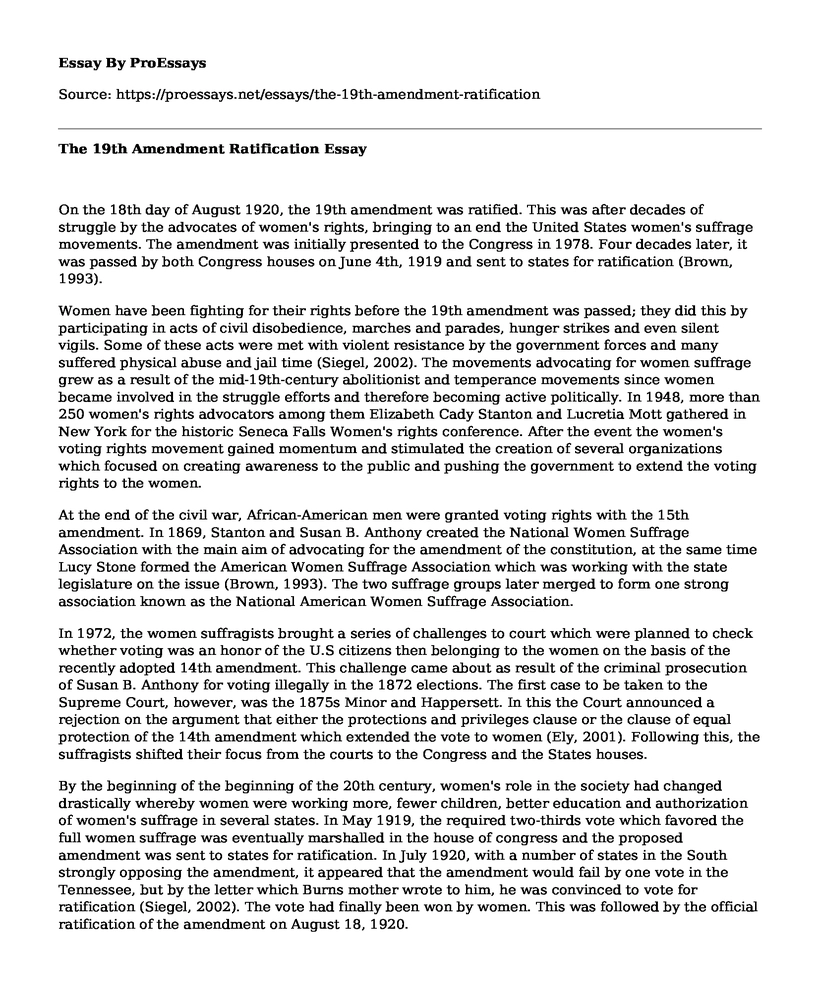On the 18th day of August 1920, the 19th amendment was ratified. This was after decades of struggle by the advocates of women's rights, bringing to an end the United States women's suffrage movements. The amendment was initially presented to the Congress in 1978. Four decades later, it was passed by both Congress houses on June 4th, 1919 and sent to states for ratification (Brown, 1993).
Women have been fighting for their rights before the 19th amendment was passed; they did this by participating in acts of civil disobedience, marches and parades, hunger strikes and even silent vigils. Some of these acts were met with violent resistance by the government forces and many suffered physical abuse and jail time (Siegel, 2002). The movements advocating for women suffrage grew as a result of the mid-19th-century abolitionist and temperance movements since women became involved in the struggle efforts and therefore becoming active politically. In 1948, more than 250 women's rights advocators among them Elizabeth Cady Stanton and Lucretia Mott gathered in New York for the historic Seneca Falls Women's rights conference. After the event the women's voting rights movement gained momentum and stimulated the creation of several organizations which focused on creating awareness to the public and pushing the government to extend the voting rights to the women.
At the end of the civil war, African-American men were granted voting rights with the 15th amendment. In 1869, Stanton and Susan B. Anthony created the National Women Suffrage Association with the main aim of advocating for the amendment of the constitution, at the same time Lucy Stone formed the American Women Suffrage Association which was working with the state legislature on the issue (Brown, 1993). The two suffrage groups later merged to form one strong association known as the National American Women Suffrage Association.
In 1972, the women suffragists brought a series of challenges to court which were planned to check whether voting was an honor of the U.S citizens then belonging to the women on the basis of the recently adopted 14th amendment. This challenge came about as result of the criminal prosecution of Susan B. Anthony for voting illegally in the 1872 elections. The first case to be taken to the Supreme Court, however, was the 1875s Minor and Happersett. In this the Court announced a rejection on the argument that either the protections and privileges clause or the clause of equal protection of the 14th amendment which extended the vote to women (Ely, 2001). Following this, the suffragists shifted their focus from the courts to the Congress and the States houses.
By the beginning of the beginning of the 20th century, women's role in the society had changed drastically whereby women were working more, fewer children, better education and authorization of women's suffrage in several states. In May 1919, the required two-thirds vote which favored the full women suffrage was eventually marshalled in the house of congress and the proposed amendment was sent to states for ratification. In July 1920, with a number of states in the South strongly opposing the amendment, it appeared that the amendment would fail by one vote in the Tennessee, but by the letter which Burns mother wrote to him, he was convinced to vote for ratification (Siegel, 2002). The vote had finally been won by women. This was followed by the official ratification of the amendment on August 18, 1920.
References
Brown, J. K. (1993). The Nineteenth Amendment and Women's Equality. The Yale Law Journal, 102(8), 2175-2204.
Ely, J. H. (2001). Interclausal Immunity. As published in Virginia Law Review, 87, 1185-1199.Siegel, R. B. (2002). She the People: The Nineteenth Amendment, Sex Equality, Federalism, and the Family. Harvard Law Review, 947-1046.
Cite this page
The 19th Amendment Ratification. (2021, Mar 09). Retrieved from https://proessays.net/essays/the-19th-amendment-ratification
If you are the original author of this essay and no longer wish to have it published on the ProEssays website, please click below to request its removal:
- Be Aware About Anti-Bias for Preschool
- Animal Bush Meat and Ethics Essay Example
- Should the United States Abolish Death Penalty? - Essay Sample
- The Community Intervention Strategy Paper Example
- Research Proposal on International Humanitarian Law in Displacement Refugee Law
- Immigrants Struggle: Discrimination, Deportation & Hate Crimes - Essay Sample
- Mohammed Ali: A Sensational Boxer & Active Civil Rights Participant - Essay Sample







